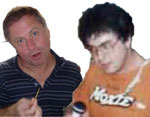Clams Ahoy!
Everything you always wanted to know about Clams but were afraid to ask!!
Clam Borne Illnesses
Clams can be Bad, and Bad Clams are VERY Bad
We would be remiss, in our discussion of clams, not to examine some of the illnesses that can result from eating unsafe product. While rare, some of these illnesses can be deadly. Each US State where shellfish are harvested has its standards and examiners to ensure safe public consumption.
No State can afford to inspect its entire harvest, however. Your best bet will always be to keep abreast of local events, know your shellfish provider and eat only clams that look, smell and taste fresh (not spoiled or ill). But every clam diner should know the basic most common illnesses caused by clams unsafe to eat. Contamination is the problem. This most often results from either unsafe clam beds or clams shucked and kept refrigerated longer than 5-8 days.
Hepatitis
Hepatitis is any inflammation of the liver. The terms Hepatitis A, B and C seem to denote a common disease, but hepatitis is rather a condition with different disease causes. Any illness involving the liver is serious. The most common form of hepatitis associated with eating clams, particularly raw ones is Hepatitis A, which is caused by septic contamination of clam beds. This is most common anywhere large numbers of people live close by to clam beds. In most people, a bout with hepatitis A brings on chills, high fever, violent nausea and other symptoms similar to flu. If you develop any of these symptoms within 24-48 hours of eating clams, visit your doctor immediately and mention what you ate. Hepatitis is extremely dangerous. Most types can be cured with alpha interferon and other treatments, but immediate care is essential as hepatitis carries with it the potential for permanent liver damage.
Typhoid
This scourge of the ancient world is not normally seen in developed countries. It is the direct result of septic contamination of groundwater. It causes extremely high fever and dehydration, along with an unusual coated throat characteristic of the disease. The typhus bacterium is highly contagious and thrives anytime there are conditions where waste material, drinking water and/or seawater mix together freely. Again, if symptoms like these appear, visit your doctor or the emergency room right away.
Red Tide
This is a problem you are most likely to read about in your local newspaper or online. Dynoflagellates endemic to coastal waters, particularly along the Northeast and Midatlantic are subject to “blooms,” periods of excessive propagation which create waterborne masses, much like clouds in the water, that float around the coastline. Red tide blooms respond to wind and wave conditions. Municipalities know to be on the lookout for red tide each year, and to test local beaches for the presence of red tide annually. The red tide organisms carry a potent neurotoxin. Nevertheless, it is rare that hospital admissions sees many people with red tide illness. Keep a careful eye on your town or city’s testing schedule before you go out clamming, so you know it is safe. Municipalities generally close beds at times of red tide by beach postings.
Contaminated Flats – the E. coli marker
After periods of heavy rain, roadtop contaminants like antifreeze, diesel, gasoline, oil and human waste are swept into local waters along with fertilizers and trash. This happens when rain amounts outstrip the capacity of local storm drains to process. After periods of heavy rain and/or flooding, biologists test for the presence of E. coli, an organism common to the human digestive tract that is a marker for the presence of more dangerous germs in the water. Wait until water quality has been confirmed OK before clamming, or swimming for that matter. Swimmer’s ear is most often caused by the type of septic contamination indicated by the presence of E. coli. Testing is very often conducted at the county level.
Spoiled Clams
A spoiled clam is one that has been out of its bed for too long. It smells bad. The flesh of such a clam lacks firmness. Do not eat clams like that. They can make you sick.
Contaminated Clams
There are areas where clams appear to flourish, that nonetheless you must avoid. Beware of any clam area downhill or proximate to sources of solvent and heavy metal contamination, such as junkyards. Heavy metals and petroleum distillates can both persist in clam flats for decades or longer. This is because the natural activity of decomposition does not affect them. Clams can take up these dangerous chemicals as they feed by filtering the water. No clam, however healthy-looking, should be eaten that comes from any area potentially contaminated with industrial chemicals. If uncertain, ask a local.
 Hi,
we are Ted and John, just two guys who love Clams and other seafood.
Hi,
we are Ted and John, just two guys who love Clams and other seafood.